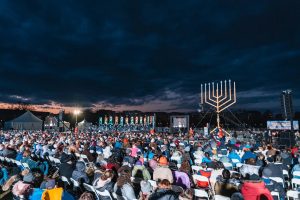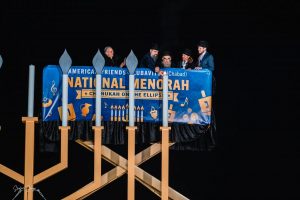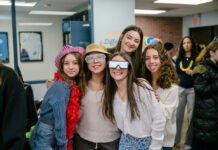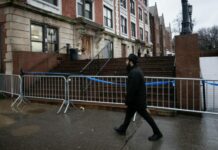
The crowd for this year’s National Menorah lighting in Washington, D.C., is expected to exceed 4,000 guests. That’s the estimate of Rabbi Levi Shemtov, executive vice president of American Friends of Lubavitch (Chabad), the group that has lit the menorah and put it on display near the White House annually since 1979.
In its first year, the White House Chanukah candelabra was a humble 4 feet tall; today, it’s about 30 feet. And just as the menorah has grown in size, so, too, have the crowds to see the spectacle. Shemtov expects this year’s turnout to surpass the pre-COVID crowds.
This year, he adds, the menorah lighting on Sunday, Dec. 18 — the first night of the eight-day holiday — is especially important. In a climate of increasing antisemitism, the menorah represents defiance against hate, as it did 2,000 years ago when the Maccabees overthrew their Greek-Syrian oppressors, the sustained light of the menorah representing Jewish resistance.
“The central message of Chanukah is that light will always prevail over darkness, no matter how dark it seems,” Shemtov said. “And this story hasn’t changed in millennia.”
For thousands of years, the menorah has been a symbol of Chanukah’s message of resilience and Jewish pride, but its presence in America’s public sphere has only emerged relatively recently — for the past 48 years, in which time it endured a Supreme Court case, dissent within the Jewish community, a pandemic and a rising tide of antisemitism.
However, year after year — though not without controversy — it still emerges as a motif of both Jewish grit and joy.
Before Levi Shemtov became the steward of the National Menorah lighting, the torch was held by his father, Rabbi Abraham (Avrohom) Shemtov.
In December 1974, the elder Shemtov, regional director of the Philadelphia Lubavitcher Center, organized the nation’s first public lighting in Philadelphia in front of Independence Hall. The menorah itself was small — white and made of wood — not even coming up to the collarbones of the rabbi and four yeshivah students accompanying him.
Though the celebration was understated, it was a snapshot of American culture, Jewish and not. It came two decades after the Rebbe — Rabbi Menachem Mendel Schneerson — took over the leadership of the Chabad-Lubavitch movement in 1951, when he began transforming Chabad from an insular group to a widespread Jewish philosophy, according to Maya Balakirsky Katz, assistant professor of Jewish art at Bar-Ilan University in Israel and author of “The Visual Culture of Chabad.”
‘Just wake them up’
In the years following the Holocaust, the Rebbe wanted to instill deep Jewish pride and rejuvenate American Jews from assimilation that could diminish Jewish identity.
“Their intrinsic value was to go wherever you need to go to find any last Jew: Just wake them up, not religiously, but to their culture, to their selfhood and to their nationhood as Jews,” Katz said of what is now the well-known Chabad modus operandi.
In the early 1960s, President John F. Kennedy created the Peace Corps, designed to send young American volunteers overseas to advance U.S. ideals such as democracy. Schneerson, said Katz, employed a similar strategy, sending Jewish emissaries (shluchim), throughout the country and the world to boost Jewish life and education.
Publicizing the miracle
Before that, Jewish rituals and celebrations were relatively private affairs.
“Public Chanukah menorah-lighting was not considered something we do. Like, you do it in your home; be modest, a man in the street,” Katz says of the Jewish thought at the time. “He was like, ‘You’re mixing it all up; [be a] Jew in the street, be a man at home.’ ”
The 1974 menorah lighting in Philadelphia — and a 1975 lighting by Chabad Rabbi Chaim Drizin of the Bill Graham Menorah at Union Square in San Francisco, a monumental 25-foot tall structure — followed Schneerson’s 1973 campaign to deliver mass-produced tin menorahs to Jews, encouraging them to light candles.

Shemtov saw the menorah as a symbol that occupied a liminal space between public and private, sitting near the window of a home where it spread warmth inside, while visible to viewers outside. A public lighting of the menorah still occupied this similar space, he argued. Far from just publicity, the public lighting extended the spiritual message of Chanukah and fulfilled the mitzvah of pirsum hanes, the “publicizing” or “proclamation” of the miracle of the day’s worth of oil that lasted for eight in the traditional story of Chanukah.
“This started the whole activity, the effort and activity, which now is spread through the world; the celebration, the marking of Chanukah, is shared with the world outside,” he says.
But not all Jews welcomed the public menorah lightings. In the late 1970s, leaders from the Reform movement wrote to the Rebbe, objecting to the public lighting.
“Pushing this symbol in public spaces has far greater implications for the Jewish community than just Chanukah,” Gratz College President Zev Eleff said.
Some Jewish leaders were concerned that the public display of a menorah was a violation of the separation of church and state. Jews were particularly sensitive to this issue, he said, because “where the church operates as government, Jews do not always fare that well.”
The debate over the menorah’s role in church-state separation culminated in the 1989 Supreme Court case County of Allegheny v. American Civil Liberties Union, in which the court considered the constitutionality of the presence of a public nativity scene at the Allegheny Courthouse and an 18-foot tall menorah outside the City-County Building.
The court found that the nativity scene violated the Establishment Clause of the First Amendment, as it depicted explicitly religious content, while the menorah, like a Christmas tree, was a symbol of a holiday that had come to represent the winter holiday season and had adopted a more secular meaning in the social milieu.
The image of Chabad rabbis lighting a menorah in front of a crowd has since become iconic, with President Jimmy Carter, followed by Presidents Ronald Reagan, George H.W. Bush, Bill Clinton, George W. Bush, Barack Obama, Donald Trump and Joe Biden, taking part in a ceremonial lighting beginning in 1979. Embroiled in managing the early days of the Iranian hostage crisis, Carter made a rare emergence from the White House to light the menorah’s shamash (or “helper” candle) on the White House lawn.
‘More critical than ever’
Though the practice of public menorah lighting has grown over the years, Katz suggested that the significance of the menorah itself as a public symbol has diminished. Its presence in media, popular culture and the public eye has eroded some of its original religious substance, she believes.
While lightings may not hold the same controversy or social gravity as they did in the 1970s and ’80s, Chabad leaders of today argue that the presence of these public events is necessary in the face of both continued assimilation and growing antisemitism.
“It’s very important not to pull back because of it. We hold our ground and be bold, not to demonstrate fear,” said Rabbi Shmuel Kaplan of the Lubavitch Center in Baltimore.
But as much as rabbis are aware of the importance of Jewish visibility in the face of antisemitic intimidation, the purpose of public menorah lightings still harkens back to their original goals.
“It’s more critical in this country than ever before,” Kaplan emphasized. “Not because there’s coercion — we don’t have the coercion anymore — but because of the lack of identification. We have a serious problem with Jewish identity.”
While visible Jewishness can speak back against antisemitism, a “robust semitism” is how to truly combat antisemitism, Levi Shemtov said.
The lighting of the menorah, as a symbol for Chanukah and an age-old tale of Jewish pride in the face of bigotry and oppression has remained relevant for Jews for thousands of years and in the public eye for the past half-century. The ritual might just offer some insight into how the next generation can find unwavering Jewish identity.
“It may not be a panacea,” Shemtov acknowledged. “But it’s definitely a trigger and a good start for a very positive [holiday] experience.” JE






